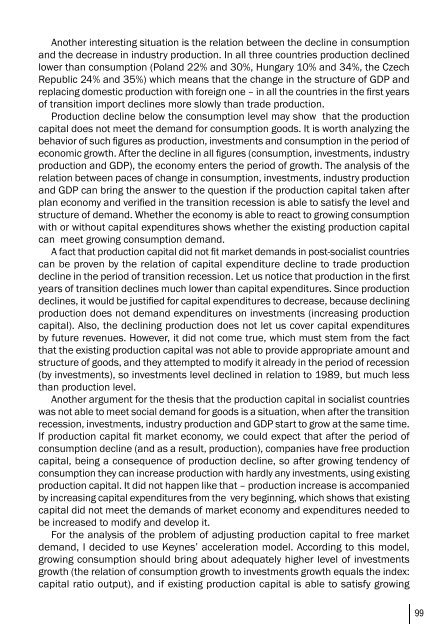art-e-conomy _ reader - marko stamenkovic
art-e-conomy _ reader - marko stamenkovic
art-e-conomy _ reader - marko stamenkovic
You also want an ePaper? Increase the reach of your titles
YUMPU automatically turns print PDFs into web optimized ePapers that Google loves.
Another interesting situation is the relation between the decline in consumption<br />
and the decrease in industry production. In all three countries production declined<br />
lower than consumption (Poland 22% and 30%, Hungary 10% and 34%, the Czech<br />
Republic 24% and 35%) which means that the change in the structure of GDP and<br />
replacing domestic production with foreign one – in all the countries in the first years<br />
of transition import declines more slowly than trade production.<br />
Production decline below the consumption level may show that the production<br />
capital does not meet the demand for consumption goods. It is worth analyzing the<br />
behavior of such figures as production, investments and consumption in the period of<br />
economic growth. After the decline in all figures (consumption, investments, industry<br />
production and GDP), the e<strong>conomy</strong> enters the period of growth. The analysis of the<br />
relation between paces of change in consumption, investments, industry production<br />
and GDP can bring the answer to the question if the production capital taken after<br />
plan e<strong>conomy</strong> and verified in the transition recession is able to satisfy the level and<br />
structure of demand. Whether the e<strong>conomy</strong> is able to react to growing consumption<br />
with or without capital expenditures shows whether the existing production capital<br />
can meet growing consumption demand.<br />
A fact that production capital did not fit market demands in post-socialist countries<br />
can be proven by the relation of capital expenditure decline to trade production<br />
decline in the period of transition recession. Let us notice that production in the first<br />
years of transition declines much lower than capital expenditures. Since production<br />
declines, it would be justified for capital expenditures to decrease, because declining<br />
production does not demand expenditures on investments (increasing production<br />
capital). Also, the declining production does not let us cover capital expenditures<br />
by future revenues. However, it did not come true, which must stem from the fact<br />
that the existing production capital was not able to provide appropriate amount and<br />
structure of goods, and they attempted to modify it already in the period of recession<br />
(by investments), so investments level declined in relation to 1989, but much less<br />
than production level.<br />
Another argument for the thesis that the production capital in socialist countries<br />
was not able to meet social demand for goods is a situation, when after the transition<br />
recession, investments, industry production and GDP st<strong>art</strong> to grow at the same time.<br />
If production capital fit market e<strong>conomy</strong>, we could expect that after the period of<br />
consumption decline (and as a result, production), companies have free production<br />
capital, being a consequence of production decline, so after growing tendency of<br />
consumption they can increase production with hardly any investments, using existing<br />
production capital. It did not happen like that – production increase is accompanied<br />
by increasing capital expenditures from the very beginning, which shows that existing<br />
capital did not meet the demands of market e<strong>conomy</strong> and expenditures needed to<br />
be increased to modify and develop it.<br />
For the analysis of the problem of adjusting production capital to free market<br />
demand, I decided to use Keynes’ acceleration model. According to this model,<br />
growing consumption should bring about adequately higher level of investments<br />
growth (the relation of consumption growth to investments growth equals the index:<br />
capital ratio output), and if existing production capital is able to satisfy growing<br />
99


